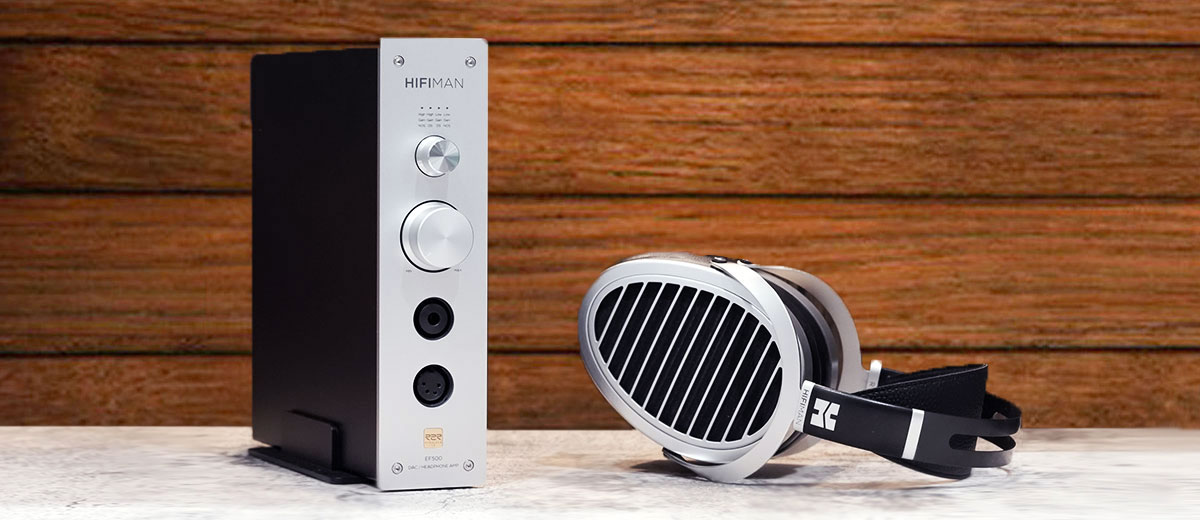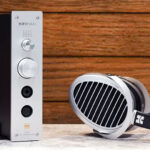In this feature, James reviews the HIFIMAN EF500, which is an integrated HYMALAYA LE R-2R-based DAC and 4.5W-capable balanced headphone amplifier. It is priced at $459.
Disclaimer: This sample was sent to us in exchange for our honest opinion. Headfonics is an independent website with no affiliate links or status. We thank the team at HIFIMAN for their support.
To read more about the HIFIMAN products we have previously covered on Headfonics click here.
Note, that this post follows our current scoring guidelines which you can read in more detail here.
HIFIMAN has been laser-focused on growing an affordable series of DACs and headphone amplifiers featuring R2R decoding which traditionally has been a reserve of their high-end models until the EF400 was launched a few years ago.
The new EF500 integrated DAC and headphone amplifier I am reviewing today fits that opening statement and is positioned between the entry-level EF400 and the EF600, previously assessed by Louis.
So, this is not their most expensive offering in this specific range. However, it is currently the most affordable option utilizing their proprietary HYMALAYA chipset, with the brand claiming that the decoding module performance is as good as the classic Texas Instruments PCM1704K.
Weighing in at 3.37KG the EF500 is built like a dumbbell, but does it pack a punch? Read on!
Features
DAC & Amplification
The HYMALAYA LE R2R chipset is designed in-house by HIFIMAN with a maximum decoding rate of PCM 24BIT/768kHz and DSD64. It is not hard to guess that it is derived from the flagship EF1000DAC costing $15,000, which utilizes four HYMALAYA PRO R2R chips.
Another difference is the THD performance, which ranges from 0.0017% to 0.0028% on the HYMALAYA LE used on the EF 500, compared to the even better <0.0015% on the EF1000DAC and 0.0015% to 0.0017% on the EF600.
The architecture of the EF500 is quite similar to that of the EF600, with the main difference being the chipsets used have a marginally higher level of distortion.
The decoding stage is followed by discreet amplification and LPF for balanced output and can output 4.5 watts max on a 32Ω load, and achieves a decent 131 dB for channel separation and 117 dB for S/N.
OS/NOS
Labelled on the front panel you can switch between NOS or OS modes by the physical knob instantly.
The NOS mode offers an unaltered, organic presentation while the OS mode delivers improved transients and enhances the dynamics. The difference is easily audible in the output and is a practical feature that helps to pair with various gears.
Streaming
The EF500 supports connecting via an ethernet cable to the router and streaming content from a Roon Core device as a Roon Bridge.
You can connect the EF500 to your home network, switch to NET+USB at the back, and choose it as an output device in Roon’s settings. That way you can control the playback on your Roon remote e.g. phone or tablet and listen on the EF500.
Similarly, you can utilize the audio playback applications on your NAS by connecting the EF500 to the same network and selecting it as a playback device. I tested Synology’s Audio Station to listen to my music library, including some online radio stations, and it worked immediately.
For Mac or Apple Music users, the EF500 supports pushing audio content via Airplay when connected to the internet. The EF500 can also act as an output device for Spotify, QQ Music, Sony Select, and various other streaming services.
Design
Much like the EF600, the EF500 has an upright design that doubles as a headphone stand. Unlike the EF600, the EF500 can be positioned sidewards when you unscrew the stand, which gives it more flexibility.
The EF500 sits sturdily on my desk as it weighs more than 3 kg, thanks to the heavy in-built transformer inside. Despite this, the EF500 is quite small and does not take up much desk space.
The mode switch and volume knob are also self-explanatory, you can switch between high and low gain, also OS and NOS modes instantly.
Overall, the design is clean and minimalist. The build quality is excellent. I know some will love its chassis solidity and certainly it feels smooth to the touch on the exterior.
I/O
On the front panel, there is a balanced XLR headphone jack as well as a provision for a 6.35mm SE output. However, be aware that there is no 4.4mm output on the front panel even though you can get a converter to use it with the XLR output.
On the back panel, this is duplicated with an XLR-terminated balanced lineout and dual RCA Out for bypassing the built-in headphones amplifier and connecting to 3rd part amps.
There is also an ethernet socket for streaming, and multiple input methods including Type-C USB in, USB-B in, and a Coaxial in. Do note that when you need to use the ethernet connection, you have to disconnect the USB cable as the connection prioritizes USB linkage.
Also, if you wish to switch between the ethernet input source or USB from coaxial or vice versa, you have to flip a switch at the back.
I am glad that HIFIMAN included both a USB-C and a USB-B for input on the unit, however, a traditional optical input would have made the EF500 even more versatile.
Packaging & Accessories
I consider the EF500 very heavy for its size and it is packed securely in a thick cardboard box with foam paddings.
On the front, the inputs and outputs are explained so you don’t need to read any accompanying user manuals. Just plug in the power cord and connect to the internet or USB-C source and you are ready for some music.
Aside from the power cord and the pre-installed stand nothing else is supplied, it would be nicer if a small screwdriver were included for those who want to convert it back to lay flat on the desk.
Sound Impressions
More than 100 hours of burn-in is given to the EF500 paired with various headphones including the HIFIMAN Ananda Nano, the MOONDROP Venus, PARA, and the FiiO FT5 planars for the impressions below.
Summary
The EF500 sounds mellow and airy for all outputs, including the XLR lineout at the back. It packs quite a punch with 4.5W power in its balanced output and kicks quite solid and deep in the low end.
The tuning is quite M-shaped with the treble well energized especially on the SE output, with good presence for the vocal range or mids as expected from the R2R structure, which pairs well with fast planar cans to sound livelier.
The EF500 offers OS and NOS modes with distinct qualities, letting users switch between the OS’s stronger transients or a more organic, smooth presentation from the NOS mode.
Timbre
One special thing about the EF500 is its timbral differences when moving between OS and NOS modes, something which is quite noticeable in the resulting amplification output.
In NOS mode, the EF500 has a powerful, smooth output that teases out some intoxicating vocal harmonics. Also, the thick resonant tones on electric guitars sound dynamic and engaging.
The power in the low end allows it to punch deep with decent texture, while at the same time giving a lot of air and presence to the bass drum and acoustic instruments.
With the OS mode, the EF500 enhances texture and clarity, further enhancing note definition. While the mid-lows are slightly forward, it does not dominate the mids and the sub-bass.
The upper mids or lower treble range is also more energetic allowing higher-pitching vocals to shine even during energetic bass passages. In contrast, the NOS mode has a softer overtone and is more naturally articulated in the upper mids.
The OS mode works particularly well for lossy tracks and streaming content, boosting the perceived resolution and sharpness. However, the NOS mode is preferred for nicely mastered tracks with stronger dynamics and relaxing music.
Staging & Dynamics
The EF500 renders a spacious and well-defined soundstage with a good level of sub-bass presence that adds texture and depth, creating an impression of listening in a small hall.
Acoustic instruments, in particular, exhibit a good sense of spatiality with a stereophonic staging quality.
With a slight boost in the upper mids, vocals easily cut through the mix while retaining a slightly thick and dense quality.
It doesn’t come too forward as the mids are still rendered quite smooth which adds more space between the listener and the vocal image It also allows accompanying instruments e.g. acoustic guitars and bass more room to stand out.
To sum up, on both OS and NOS modes, you get satisfactory dynamics, and a rendered stage size resembling that of a lecture hall. When switched to OS mode, the definition is stronger and the vocal has a clearer stereo image.
NOS mode keeps everything smoother and mellow and sounds even more engaging with more realistic depth rendered when listening to Lofi music or other relaxing tunes.
Click on page 2 below for my recommended pairings and selected comparisons.








